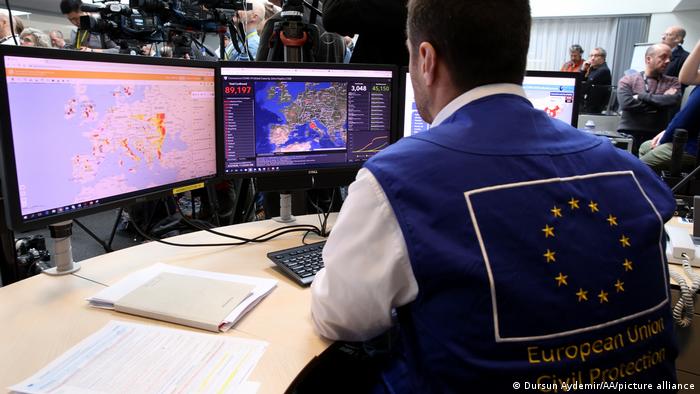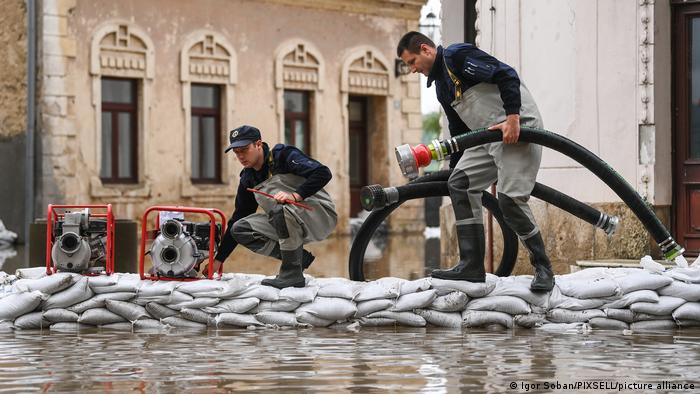The recent floods in the Italian region of Emilia-Romagna show that joint EU civil protection is becoming increasingly important. An overview of assistance and crisis management.
 < p>All trouble spots worldwide at a glance: employees of the center for the coordination of emergency measures in Brussels
< p>All trouble spots worldwide at a glance: employees of the center for the coordination of emergency measures in Brussels
In the EU, member states are not entirely on their own in the event of a disaster. Like Italy recently, you can ask other member states for help. Joint civil protection proved to be extremely important, especially during the corona pandemic.
EU support is provided both through the provision of relief supplies and equipment, as well as through coordination and mediation. After the floods in Emilia-Romagna, high-performance pump systems from three member states were shipped to Italy.
The control center of the joint European civil protection is the center for the coordination of emergency measures in Brussels (ERCC = European Response Coordination Centre). There, trouble spots are observed and requests from affected countries are processed.
Member States decide
The head office forwards the applications to member countries that offer help. Since national civil protection is within the sovereignty of the member states, they must agree to the dispatch of relief supplies.
To receive support, the member state concerned must activate the EU civil protection mechanism by sending a request to the centre.

Floods caused enormous damage not only in Italy but also in Croatia
The approximately 50 employees, from the clerk to the head of operations, then forward the request to the 27 member states and international partners. They can then offer their help in the form of rescue teams, fire-fighting aircraft or humanitarian aid supplies.
The tasks of the center now go beyond pure coordination and mediation. Since 2019, the center has also been managing the “rescEU” resource reserve, which was additionally created by the Commission. This absorbs additional hardships in times of crisis.
Field hospital and helicopter
The resource reserve includes distribution centers in ten member states where relief supplies are available. The EU reserve also includes field hospitals and mobile emergency shelters for displaced people.
The so-called “rescEU Fleet”, an EU air fleet with currently 22 aircraft, five helicopters and ground teams, which is provided by various member states, is particularly important . The EU finances maintenance, fuel and determines the locations of the fleet. It is intended to support member states in extinguishing forest fires.

Out of control: last year, large parts of Spain suffered from drought, heat and forest fires
Heat and forest fires
Last year, the fleet was used particularly often in the forest fires in France and Portugal. Because of the devastating fires in the Mediterranean region, the EU Commission estimated an additional budget of 170 million euros in October 2022 to expand the “rescEU” air fleet.
The joint EU civil protection was already in high demand in 2021: more than half of the inquiries to the Center for Civil Protection had to do with combating the corona pandemic. Both the cross-border treatment of patients and the provision of medical teams and equipment were among the biggest challenges in 2020-2022.
Aid beyond EU borders
But the EU not only helps its members, but also third countries. After the earthquake in Turkey and Syria in February this year, it was the Center's staff who coordinated the two countries' requests for help to the member states.
Floods in northern Italy
Besides the 27 EU countries, nine other countries are part of the network, such as Iceland, Turkey and Ukraine. In addition, important international organizations such as the United Nations can ask the center to coordinate EU emergency measures.
Since 2001, the EU civil protection mechanism has been triggered a total of 650 times – 106 times in the last year, especially in the context of the Russian war of aggression in Ukraine.
The war is by far the biggest crisis that the European center has coordinated to date. Among other things, additional logistical hubs were set up in Poland, Romania and Slovakia in order to transport humanitarian aid goods more quickly to Ukraine and to the refugees in neighboring countries.